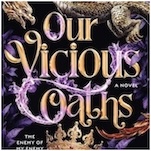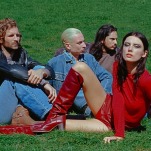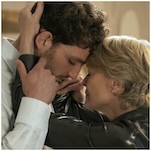Seth Rogen’s Show Biz Parody The Studio Loves Movies More Than It Hates Hollywood
Photos courtesy of Apple
The Studio’s camera never stops moving. Apple’s new show biz satire captures the stress and chaos of movie-making by almost never taking a second to catch its breath. As Seth Rogen’s harried new Hollywood studio president, eternally torn between wanting to make art and needing to make hits, regularly throws gas on the various fires he’s tasked with putting out, the camera always weaves and sweeps around him while a percussion-heavy jazz score clatters and bangs on the soundtrack. (If you couldn’t already tell The Studio was a show biz satire, the clattering and banging of that percussion-heavy jazz score would be enough to clue you in; they’re apparently mandatory for this type of thing.) An entire episode might have only one or two edits, and the second episode, “The Oner,” blatantly calls attention to this affectation; it’s a one-shot episode about the filming of a one-shot movie scene. The music’s stressful, the tension’s always escalating, and there’s hardly ever any release through editing, and although this is all very showy and ostentatious, there’s also a point to all of it. The Studio’s chaotic structure formally reflects the mental state of its lead character, who dominates the show as much as Larry David does Curb Your Enthusiasm—a comedy that The Studio often resembles.
If the cliche is accurate, Hollywood studios love influence math—when a pitch can be summed up as one popular property plus another popular property. The Studio has the show biz intrigue (and tracking shot) of The Player, the frantic music of Birdman, and the cringe comedy of Curb Your Enthusiasm. It also has an amazing cast—most of whom are barely in it. And in Rogen it has a great comedian to build around—although one whose strengths aren’t a good fit for truly incisive, cynical satire.
Rogen’s charm has always been tied to his affable everyman stature. He’s legitimately funny but also fundamentally seems like a nice guy, somebody you could hang out with and be friends with in real life. That likability resurfaces in Continental Studios head Matt Remick, his Studio character, which softens the show’s tone. The Studio squarely targets the entertainment industry (the closest thing it has to a season-long story is Continental trying to make a movie about Kool-Aid), and Remick routinely embarrasses himself as much as Larry does in Curb, but Remick largely remains an amiable, sympathetic character, and outside of Bryan Cranston’s guest role as a slimy CEO, the show is never quite as critical of Hollywood as you might expect. The problems Matt faces (and causes) are rooted in the business itself and the compromises he’s compelled to make in hopes of succeeding in it more than they are with him or his personality, and art can still happen in spite of studio interference. Matt doesn’t want to make a Kool-Aid movie, we know he doesn’t want to make a Kool-Aid movie, and yet he crumbles immediately and starts making a Kool-Aid movie because Kool-Aid’s Q score is through the roof and making money is the only way to keep his job. Don’t expect a satire as dark as The Player, where the surest path to success is having no morals or scruples, and where everybody, even the artists, will sell out their convictions in an instant; The Studio criticizes the business, and has no problem making Remick into a cringe-worthy fool, but his flaws are closer to Michael Scott’s thoughtlessness than the cruelty and cravenness of David Brent.
The Studio’s insistence on making its characters broadly likable extends beyond Rogen’s lead. Ike Barinholtz plays another Continental exec, Sal Seperstein, who, in the first episode, seems positioned to be Matt’s rival. Instead he almost immediately gets over his disappointment about losing the top job to Matt and remains a good, loyal friend to his new boss. Despite his flashy, Hollywood bro tendencies—he’s a glad-handing cheese ball with a coke habit—Sal’s pretty much a good guy, Matt’s comic sidekick who also serves as a slightly less embarrassing counterpoint to Matt’s cringiest behavior. Barinholtz is also the only cast member beyond Rogen to really get a substantial amount of screen time over the first season, and that points to what might be The Studio’s biggest problem: it just doesn’t use the rest of its cast enough.
-

-

-

-

-

-

-

-

-

-

-

-

-

-

-

-

-

-

-

-

-

-

-

-

-

-

-

-

-

-

-

-

-

-

-

-

-

-

-

-








































